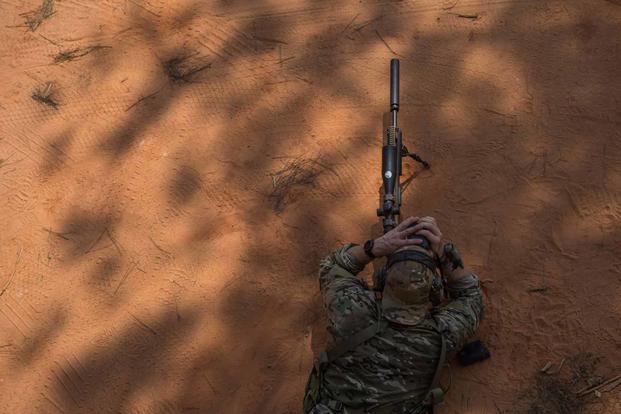The Air Force's effort to transform its old special operations weather team airmen into special reconnaissance airmen took a big step forward Thursday with the graduation of the new job's first apprentice course class.
Just two new special reconnaissance airmen graduated at Pope Army Airfield in North Carolina on Thursday, along with seven combat controllers and a special tactics officer. But in a Wednesday interview, Maj. Spencer Reed, commander of the 352nd Special Warfare Training Squadron at Pope, said it marks a milestone in standing up the new career field, and improving how the Air Force conducts recon operations.
And in future conflicts, these special reconnaissance airmen could deploy alongside teams of Green Berets or other special operators, and fly small quadcopter drones or use other recon tactics to collect vital intelligence on air or other threats needed in the field.
Read Next: Army National Guard to Halt Re-Up Bonuses Amid Sky-High Retention
"The core tenet of reconnaissance is gathering information," Reed said. "So let's make sure we're postured to gather the information that we want to be able to gather -- keeping in mind that future conflicts are going to look probably pretty different than the conflicts for the past 20 years in the Middle East."
The old special operations weather team, or SOWT, career field, which specialized in analyzing weather in the field, was "a pretty niche career field," Reed said.
So in 2019, as the military began to shift away from counterterrorism and counterinsurgency and prepare for a potential "great power" conflict against a major adversary, the Air Force completely revamped the SOWT career field. They were transformed into special reconnaissance, and the scope of their job was broadened to provide greater reconnaissance abilities in the field and fill a gap in the military's capabilities.
The old SOWT training used to take about 215 days, across multiple courses and training locations. For example, SOWTs used to begin their training at Keesler Air Force Base in Mississippi, spending a great time learning about weather and forecasting.
Now, special reconnaissance airmen come straight to Pope, which Reed said has shortened the pipeline significantly, and they only need 86 training days.
Special reconnaissance airmen, all of whom are enlisted, still receive some weather training at the apprentice course, but it's been scaled far back from what SOWTs learned.
Instead, they are taught several of the same common core skills learned by other special warfare airmen at the 352nd, such as land navigation, communications and small-unit tactics.
But Reed said special reconnaissance airmen will also learn new, unique skills at Pope, such as long-range target interdiction; intelligence gathering to help their ground force commander plan; and high-frequency communications.
High-frequency communications training had "kind of fallen out of favor" in the Air Force, Reed said. But with satellite communications, or SATCOM, becoming more prevalent, he said, the Air Force is seeing more need to use HF communications and hone airmen's skills to transmit both voice and data that way.
Special reconnaissance airmen also learn how to use small unmanned aerial systems such as quadcopters, Reed said.
This will give airmen their own "eye-in-the-sky" to get their units intel in the field, when something like a full-fledged MQ-9 Reaper is unavailable. For example, a special reconnaissance airman attached to a SEAL platoon could carry a quadcopter in his kit and bust it out when the unit needs to know whether there's two enemy fighters on the other side of a ridge -- or two dozen.
But quadcopters would only be one tool in their toolkit, Reed said. Special reconnaissance airmen are learning many more fundamental recon skills at Pope.
Special reconnaissance airmen also could be deployed ahead of a SOF unit, instead of alongside, observe the target area and report that intel back.
"We use these foundational reconnaissance skills and the different tools that the airmen have ... in ways that other reconnaissance elements are not doing," Reed said. "Nobody's arguing that the Marines don't do reconnaissance or the Army doesn't do it. [But] they don't necessarily see things the way that our guys see them based on their airmanship background."
In a potential "great power competition" conflict, Reed said, troops might have to operate on a battlefield where the U.S. doesn't have air superiority for the first time since the Korean War. And the U.S. will need recon troops on the ground that specialize in finding and reporting enemy air threats such anti-aircraft systems, Reed said.
"Our reconnaissance forces are postured to be able to see things that are on the ground and translate that into the potential threat that is to aircraft, understand all the implications, and pass that information back," Reed said.
But special reconnaissance airmen would also still be useful in a counterterror or counterinsurgency fight, or across the range of special operations missions, Reed said.
Right now, special reconnaissance airmen work in Air Force special tactics squadrons alongside combat controllers, pararescuemen, special tactics officers, and tactical air control party airmen. But in the future, Reed said it's possible that they could be embedded with joint forces.
The apprentice course isn't just for new recruits. Airmen who have already enlisted can also attend as part of the process for cross-training into special reconnaissance.
But before arriving at Pope, most airmen will have to attend other courses to learn necessary skills, such as Army Airborne School to get their static line parachuting qualification, and to Survival Evasion Resistance and Escape School, or SERE.
Now that those two airmen have graduated, they are officially special reconnaissance airmen and can wear their berets and blouse their pants in their jump boots -- but their training isn't done yet. They'll head straight to Hurlburt Field in Florida to learn more advanced skills.
COVID-19 didn't throw many serious curveballs into the standup of the new apprentice course, Reed said, although the pandemic slowed some vendors' ability to manufacture the small drones the Air Force needed.
The Air Force in late 2019 conducted a beta training course for special reconnaissance airmen at Hurlburt, to figure out what core tasks they would need to learn for each skill level.
This first special reconnaissance apprentice course began in mid-February.
The Air Force has fewer than 150 special reconnaissance airmen.
-- Stephen Losey can be reached at stephen.losey@military.com. Follow him on Twitter @StephenLosey.
Related: As Afghanistan War Ends, General Sees New Opportunities for Special Operations












